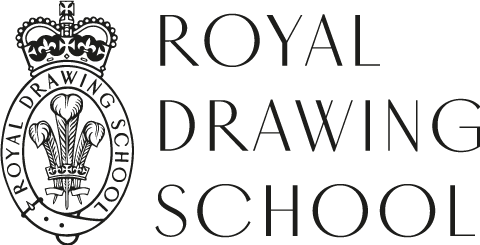Drawing Self-Portraits: The Drama of Light and Shadow
Painting: Portraits and Self-Portraits tutor Sophie Charalambous sets some exercises that explore the use of light and dark in creating dramatic portraits.

Drawing by Isobel Neviazsky
Playing with the balance of light and dark in a portrait can be a good way to simplify, model the illusion of three dimensionality and create theatrical effects.
 Lady Dorothy Bradshaigh 1785
Lady Dorothy Bradshaigh 1785
In his 'Natural History' Pliny the Elder records how portraiture began by tracing a man’s shadow on the wall in candlelight, it appears that the ancient Greek term for illusionistic painting was skiagraphia – which literally translates as “shadow painting”.

L’Origine de la peinture 1765
Later the technique of “Chiaroscuro” painting (derived from the Italian words for light chiaro and dark scuro ) became popular with artist’s from Leonardo da Vinci to Artemisia Gentileschi and probably most famously Caravaggio who “transformed chiaroscuro into a vehicle for sensational theatricality in which light and shadow don’t so much as balance each other as battle for supremacy.” More recently these ideas can be seen in tonal portrait drawings by George Seurat, Kathe Kollowitz and Frank Aurbach which display striking abruptness of transitions between light and dark, heightening a feeling of drama and mystery.

Drawing by Seurat

Self-Portrait by Kathe Kollwitz
Drawing exercise - 5 drawings (7minutes for each drawing)
You will need a mirror or a model
A strong side light source- a spotlight or window
Scissors
Black conte or charcoal
White conte or chalk
3 sheets black paper, 1 sheet white paper, 1 sheet mid tone paper (grey, ochre, etc)
Drawing One (One Tone) Silhouette.
Sit sideways to the mirror or ask your model to sit in profile
On the black paper draw with the white material start at the centre top of the head and draw the profile line of the front of the face and neck, next draw the profile of the back of the head. Think about the relationship and distance between the two lines. When you are happy cut it out!
Drawing Two (Two Tones) Draw the dark tones.
Sit front on with a strong side light from the side.
On the white paper draw with the black material only the dark tones you see, it helps to squint to simplify the tones out into light and dark. Think about the space around the head as well is t light or dark? Try to think in terms of strong shapes rather than line

Portrait by Marina Renee Cemmick, public programme student
Drawing Three (Two Tones) Draw the light.
Sit front on with a strong side light from the side.
Same exercise as above but this time draw on the black paper with the white material, this time drawing the light.

Portrait of Sophie by Anne Rowland, public programme student in Drawing the Contemporary Portrait
Drawing Four (Three Tones).
Sit front on with a strong side light from the side.
Next drawing work on the mid tone paper with the light and dark materials
Draw the light on the face first as you have done in the previous drawing, next put the dark tones in with the black material. In this drawing let the paper do some of the work and read as a mid-tone, again make tonal decisions across the whole drawing including the space around the head.
Drawing Five (Three Tones).
Sit front on with a strong side light from the side.
Same exercise as above but this time on the black paper, again start with the white material and draw the light. Then use the black material to put in only the deep shadows. The difference between this drawing and the last will be more dramatic as the contrast is stronger on the black paper.

Self Portrait by Olive Haigh in Portraits and Self Portraits
These are all student warm up drawings, all 7 minutes.



